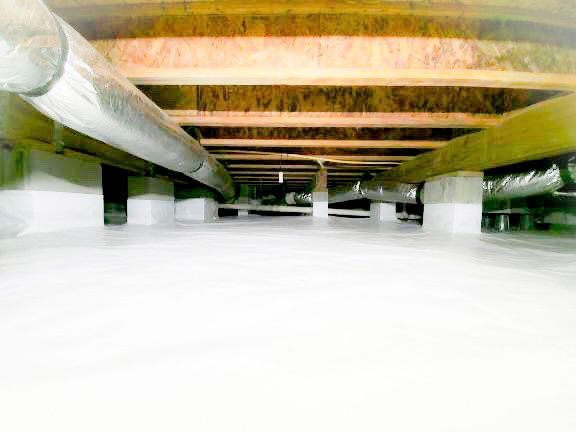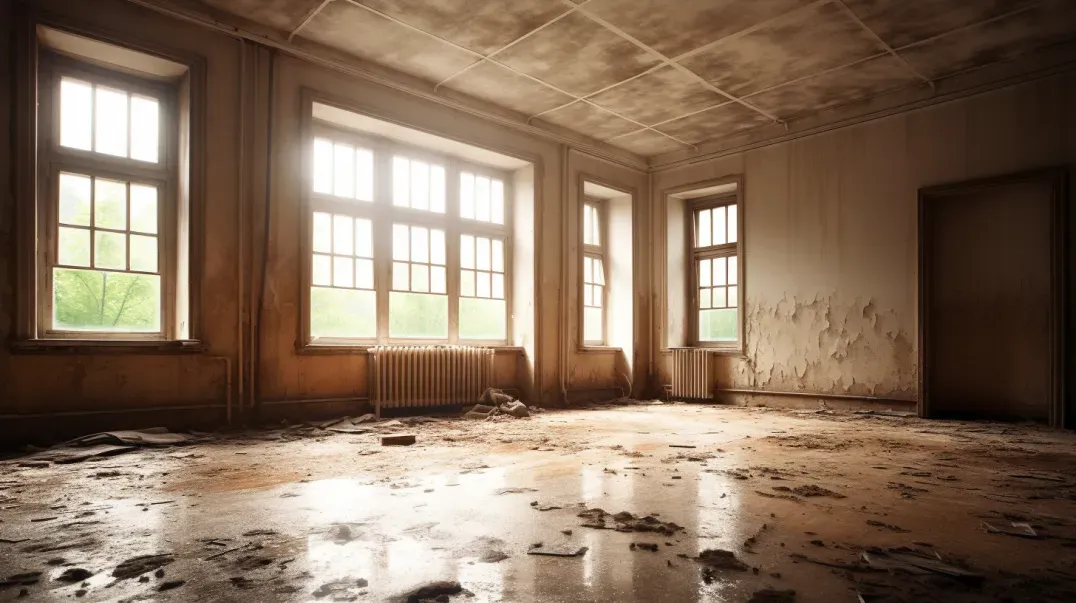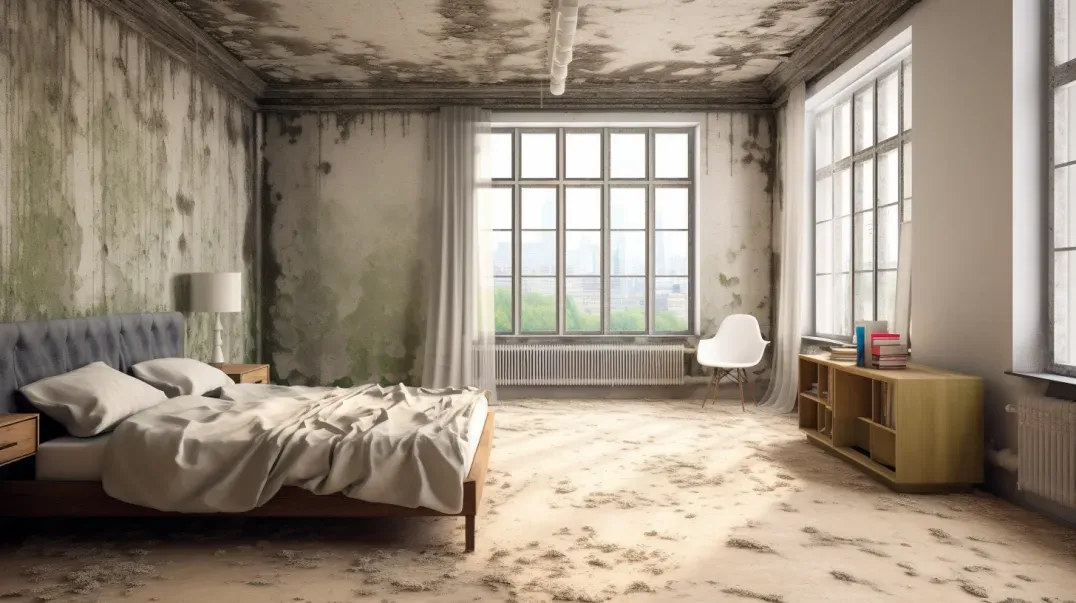Unveiling the Hidden Threat: Mold in Crawl Spaces
Welcome to our comprehensive exploration of a commonly overlooked yet critical issue in home maintenance – the prevalence and risks of mold in crawl spaces. Often hidden from plain sight, mold in these under-the-house areas poses significant health and structural risks, making its early detection and remediation not just advisable, but essential.
In this article, we delve into the mysterious world beneath your feet, uncovering the reasons why crawl spaces are prone to mold growth. We'll explore the various types of mold commonly found in these areas and the specific conditions that foster their growth. Understanding the environment in which mold thrives is key to preventing its occurrence.
But why should you be concerned about mold in your crawl space? We'll discuss the potential health risks associated with mold exposure, which range from mild allergic reactions to more severe respiratory issues. These risks underscore the importance of maintaining a mold-free environment, especially in areas of your home that are out of sight.
Moreover, we'll guide you through the early signs of mold growth in crawl spaces. Early detection is crucial, as it can prevent the spread of mold and minimize both health risks and structural damage to your home. We'll provide you with practical tips and strategies for identifying mold early on.
Finally, we'll walk you through the steps of effective mold remediation. Whether you're a DIY enthusiast or prefer professional help, understanding the remediation process is vital for ensuring a safe and healthy living environment. We'll also discuss preventive measures to keep mold at bay in the future.
Understanding Mold: Basics and Health Implications
Mold is more than just an unsightly nuisance; it's a complex organism with significant implications for our health and homes. In this section, we'll explore the fundamental aspects of mold and its potential impact on health, especially for sensitive groups.
What is Mold?
Mold is a type of fungus that plays a crucial role in nature by breaking down dead organic matter. However, when it grows unchecked in our homes, it becomes a cause for concern. Mold reproduces through tiny spores that float through the air, invisible to the naked eye. These spores thrive in moist environments, making damp areas in homes, like crawl spaces and bathrooms, common sites for mold growth.
There are various types of mold commonly found in homes, each with its unique characteristics and potential health risks. Some of the most common household molds include:
- Aspergillus: Often found on food and in air conditioning systems, this mold can cause allergic reactions and respiratory infections.
- Cladosporium: Typically found on fabrics and wood surfaces, it can trigger allergies and asthma.
- Stachybotrys: Also known as "black mold," it's particularly concerning due to its association with severe health problems, including respiratory issues.
Understanding these types and their preferred habitats is key to preventing and controlling mold growth in your home.
Health Risks Associated with Mold
The presence of mold in homes can lead to a range of health issues, affecting individuals differently based on their sensitivity and overall health.
Short-term health effects of mold exposure can include symptoms such as sneezing, coughing, throat irritation, nasal congestion, and skin rashes. These symptoms are particularly prevalent in individuals with allergies or asthma.
Long-term health effects can be more severe, especially with prolonged exposure to mold. These may include chronic respiratory conditions, persistent headaches, fatigue, and in extreme cases, neurological issues.
Special considerations for sensitive groups: Certain individuals are more susceptible to the effects of mold. These include:
- Children: Their developing respiratory systems make them more vulnerable to mold-related health issues.
- Elderly: Aging immune systems can be less effective at fighting off mold-related infections and illnesses.
- Individuals with Respiratory Issues: Those with pre-existing respiratory conditions, such as asthma or chronic lung diseases, are at a higher risk of experiencing exacerbated symptoms.
Understanding the health risks associated with mold is crucial for protecting the well-being of all household members, especially those in sensitive groups. This knowledge empowers homeowners to take proactive steps in mold prevention and remediation, ensuring a healthier living environment.
Causes of Mold in Crawl Spaces
Understanding the causes of mold growth in crawl spaces is essential for effective prevention and remediation. Mold thrives in specific conditions, and by controlling these factors, you can significantly reduce the risk of mold infestation in your home. Let's explore the primary causes of mold in crawl spaces.
Poor Ventilation and Air Circulation
One of the key contributors to mold growth in crawl spaces is inadequate ventilation. Proper air circulation is crucial in these areas to prevent the accumulation of moist, stagnant air, which creates an ideal environment for mold spores to flourish.
When crawl spaces lack sufficient ventilation, the humidity levels rise. This increased moisture, combined with limited air movement, allows mold to grow unchecked. It's important to ensure that crawl spaces have adequate venting systems to facilitate air exchange with the outside. This can be achieved through vents or a crawl space dehumidifier, which helps maintain a dry and less hospitable environment for mold.
Water Leaks and Flooding
Water intrusion is another major factor in mold growth in crawl spaces. Common sources of water leaks include:
- Plumbing Leaks: Faulty or aging pipes can leak water into crawl spaces.
- Groundwater Seepage: Especially in areas with high water tables, water can seep into crawl spaces from the surrounding soil.
- Flooding: Heavy rains and flooding events can introduce large amounts of water into crawl spaces, which can be difficult to fully remove.
Addressing these water sources is critical. Regular inspections of plumbing systems and crawl space foundations can help identify potential issues before they lead to significant water accumulation and mold growth.
Condensation Issues
Condensation occurs when warm, moist air comes into contact with cooler surfaces, such as the walls and floors of a crawl space. This temperature difference can lead to the formation of condensation, providing another source of moisture for mold to thrive.
In crawl spaces, condensation is often exacerbated by external factors such as climate, seasonal changes, and heating and cooling systems in the home. To mitigate condensation, it's important to maintain a consistent temperature in the crawl space and ensure proper insulation. This helps minimize the temperature differential between the air and surfaces within the crawl space, reducing the likelihood of condensation and subsequent mold growth.
Preventing and Treating Mold in Crawl Spaces
The battle against mold in crawl spaces is twofold: prevention and treatment. By regularly inspecting and maintaining these areas, and understanding the best remediation techniques, homeowners can effectively manage and prevent mold growth. Let's explore the strategies for both preventing and treating mold in crawl spaces.
Regular Inspections and Maintenance
Routine inspection and maintenance are key to preventing mold growth in crawl spaces. Here's a checklist for your crawl space inspection:
- Check for Water Leaks: Look for any signs of plumbing leaks or groundwater seepage.
- Inspect Ventilation: Ensure that vents are clear and functioning properly.
- Look for Condensation: Check for signs of condensation on pipes and crawl space surfaces.
- Examine Insulation: Make sure insulation is dry and properly installed.
- Search for Mold: Look for visible signs of mold growth on wood, insulation, or other materials.
- Assess Humidity Levels: Consider using a hygrometer to measure the humidity level, which should ideally be below 60%.
Regular maintenance, including cleaning and clearing vents, fixing leaks, and ensuring proper insulation, can significantly reduce the risk of mold growth.
Mold Remediation Techniques
When it comes to mold remediation, there are both professional and DIY approaches, each with its own considerations:
- Professional Remediation: Ideal for extensive mold problems. Professionals have the expertise, equipment, and protective gear to safely and effectively remove mold.
- DIY Approaches: Suitable for smaller areas of mold. It involves cleaning the affected area with mold-killing solutions like diluted bleach, vinegar, or commercial products. Always wear protective gear, including gloves, goggles, and a mask.
- Safety Precautions: Whether you opt for a DIY approach or professional help, safety is paramount. Ensure good ventilation during the remediation process and use appropriate protective gear to avoid exposure to mold and chemicals.
Long-term Solutions for Mold Prevention
To prevent mold recurrence, consider these long-term strategies:
- Improving Ventilation and Air Circulation: Install vents or fans to promote air exchange. Consider using a dehumidifier to maintain low humidity levels.
- Waterproofing and Moisture Control: Address external water issues with proper drainage and waterproofing measures. Seal any cracks or openings in the foundation to prevent water intrusion.
Implementing these solutions can create an environment that is less conducive to mold growth, ensuring the long-term health and safety of your home.
When to Call a Professional: Seeking Expert Help
While some mold issues can be addressed with DIY methods, there are situations where calling in a professional is not just advisable, but necessary. Understanding when to seek expert help and how to choose the right mold remediation service is crucial for effectively handling severe mold infestations.
Assessing the Severity of Mold Infestation
Recognizing the severity of a mold problem is key to determining whether professional remediation is required. Here are some indicators that it's time to call in the experts:
- Extensive Mold Growth: If the mold covers a large area (typically over 10 square feet), it's advisable to seek professional help.
- HVAC System Contamination: If mold is present in your heating, ventilation, and air conditioning system, professional cleaning is necessary to prevent the spread of spores throughout your home.
- Mold After Flooding: Mold resulting from flood water, especially if it includes sewage or other hazardous materials, requires professional attention.
- Health Concerns: If occupants of the home are experiencing health issues that may be related to mold exposure, professional remediation is crucial.
In these cases, DIY methods may not be sufficient, and professional intervention is necessary to ensure the mold is safely and effectively removed.
Choosing the Right Mold Remediation Service
Selecting a reputable and experienced mold remediation service is essential. Here are some criteria to consider when choosing a service provider:
- Certifications and Experience: Look for a company with certified professionals who have specific training and experience in mold remediation.
- References and Reviews: Check for customer reviews and ask for references to gauge the company's reputation and quality of work.
- Inspection and Assessment: A reputable company will offer a thorough inspection and assessment of your mold issue before proposing a remediation plan.
- Detailed Plan and Explanation: Expect a detailed plan of action. The company should explain their process, the equipment they use, and the safety measures they implement.
- Insurance and Guarantees: Ensure the company has liability insurance and offers some form of guarantee on their work.
- Post-Remediation Assessment: A good service provider will offer a post-remediation assessment to ensure that the mold issue has been fully resolved.
Choosing the right professional is critical to effectively addressing your mold problem and ensuring the long-term health and safety of your home environment.
Identifying Signs of Mold in Your Crawl Space
Detecting mold in its early stages is crucial for preventing its spread and mitigating potential health risks. Crawl spaces, often out of sight, can harbor mold without immediate detection. This section will guide you through the key signs of mold presence in your crawl space, helping you to identify and address mold issues promptly.
Visual Indicators of Mold
Mold often reveals itself through distinct visual signs. Regular inspections of your crawl space can help in early detection. Look out for:
- Dark Patches on Wood or Insulation: Mold often appears as irregular dark patches on organic materials like wood and insulation.
- White, Green, or Black Spots on Walls: These spots can vary in color and size, indicating different types of mold growth.
- Discoloration and Spots on Surfaces: Any unusual discoloration or spotting on crawl space surfaces should be investigated as potential mold growth.
These visual cues are often the first indicators of a mold problem and should prompt further investigation or remediation efforts.
Musty Odors and Air Quality Changes
Mold can significantly impact the air quality in your home, often signaled by a distinct musty odor. This smell is typically earthy and damp, indicative of microbial growth. If you notice a persistent musty smell emanating from your crawl space, it's a strong sign that mold is present.
The impact on air quality can extend beyond odors. Mold spores can circulate through your home, potentially affecting the health of residents, particularly those with allergies or respiratory issues. Addressing mold odors promptly can help maintain a healthy living environment.
Increased Humidity and Moisture Levels
Mold thrives in moist environments, making humidity and moisture key factors in its growth. Understanding how moisture contributes to mold is essential:
- Moisture Sources: Look for any signs of water intrusion, leaks, or condensation in your crawl space.
- Humidity Levels: High humidity levels provide the perfect breeding ground for mold.
To monitor these conditions, consider using tools like hygrometers or moisture meters. These devices can help you keep track of the humidity and moisture levels in your crawl space, enabling you to take timely action if levels rise beyond the mold-preventive threshold.
FAQs
Contact Lowcountry Crawlspaces Today!
Lowcountry Crawlspaces will do everything we can to ensure your experience with us is excellent.
Request A FREE Estimate
CHECKOUT RECENT POST



Schedule Your FREE Crawl Space Evaluation Today
There Is No Crawl Space Job We Can’t Fix!




